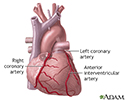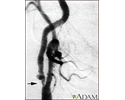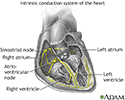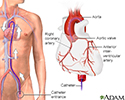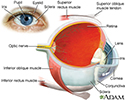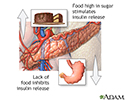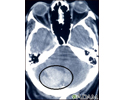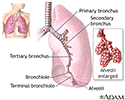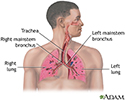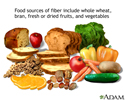Multimedia Gallery









Coronary artery balloon angioplasty - series
Coronary artery balloon angioplasty - Series
The coronary arteries supply blood to the heart muscle. The right coronary artery supplies both the left and the right heart; the left coronary artery supplies the left heart.
Coronary artery balloon angioplasty - series
Coronary artery balloon angioplasty - Series
The coronary arteries supply blood to the heart muscle. The right coronary artery supplies both the left and the right heart; the left coronary arter...
Coronary artery balloon angioplasty - series
Indication
Fat and cholesterol accumulates on the inside of arteries (atherosclerosis). The small arteries of the heart muscle (the coronary arteries) can be narrowed or blocked by this accumulation. If the narrowing is small, percutaneous transluminal coronary angioplasty, or PTCA for short, may be the course for treatment. PTCA is a minimally invasive procedure to open up blocked coronary arteries, allowing blood to circulate unobstructed to the heart muscle. The indications for PTCA are:
- Persistent chest pain (angina)
- Blockage of only one or two coronary arteries
Coronary artery balloon angioplasty - series
Indication
Fat and cholesterol accumulates on the inside of arteries (atherosclerosis). The small arteries of the heart muscle (the coronary arteries) can be na...
Coronary artery balloon angioplasty - series
Procedure, part 1
While the patient is awake and pain-free (local anesthesia), a catheter is inserted into an artery at the top of the leg (the femoral artery). The procedure begins with the doctor injecting some local anesthesia into the groin area and putting a needle into the femoral artery (the blood vessel that runs from the heart down the leg). Once the needle is inserted, a guide wire is placed through the needle, into the blood vessel. Following this step, the guide wire is left in the blood vessel and the needle is removed. A large needle called an introducer is then placed over the guide wire and the guide wire is removed.
Coronary artery balloon angioplasty - series
Procedure, part 1
While the patient is awake and pain-free (local anesthesia), a catheter is inserted into an artery at the top of the leg (the femoral artery). The pr...
Coronary artery balloon angioplasty - series
Procedure, part 2
Next, a diagnostic catheter, which is a long narrow tube, is advanced through the introducer over a .035 inch (.0889 cm) guidewire, into the blood vessel. This catheter is then guided to the aorta and the guidewire is removed. Once the catheter is placed in the opening or ostium of one of the coronary arteries, the doctor injects dye and takes a series of X-rays (film of the images).
Coronary artery balloon angioplasty - series
Procedure, part 2
Next, a diagnostic catheter, which is a long narrow tube, is advanced through the introducer over a .035 inch (.0889 cm) guidewire, into the blood ve...
Coronary artery balloon angioplasty - series
Procedure, part 3
The first catheter is exchanged out over the guidewire for a guiding catheter and the guidewire is removed. A smaller guidewire is advanced across the blocked section of the coronary artery and a balloon-tipped tube is positioned so the balloon part of the tube is beside the blockage. The balloon is then inflated for a few seconds to compress the blockage against the artery wall. Then the balloon is deflated. The doctor may repeat this a few times, each time pumping up the balloon a little more to widen the passage for the blood to flow through. This treatment may be repeated at each blocked site in the coronary arteries.
Coronary artery balloon angioplasty - series
Procedure, part 3
The first catheter is exchanged out over the guidewire for a guiding catheter and the guidewire is removed. A smaller guidewire is advanced across th...
Coronary artery balloon angioplasty - series
Procedure, part 4
A device called a stent may be placed. A stent is a latticed, metal scaffold that is placed within the coronary artery to keep the vessel open.
Coronary artery balloon angioplasty - series
Procedure, part 4
A device called a stent may be placed. A stent is a latticed, metal scaffold that is placed within the coronary artery to keep the vessel open.
Coronary artery balloon angioplasty - series
Procedure, part 5
Once the catheter has been positioned at the coronary artery origin, contrast media is injected and a series of X-rays (film) are taken to check for any change in the arteries. Following this, the catheter is removed and the procedure is completed.
Coronary artery balloon angioplasty - series
Procedure, part 5
Once the catheter has been positioned at the coronary artery origin, contrast media is injected and a series of X-rays (film) are taken to check for ...
Coronary artery balloon angioplasty - series
Aftercare, part 1
This procedure can greatly improve the blood flow through the coronary arteries and to the heart tissue in about 90% of patients and may eliminate the need for coronary artery bypass surgery. The outcome is relief from chest pain symptoms and an improved exercise capacity. In 2 out of 3 cases, the procedure is considered successful with complete elimination of the narrowing or blockage.
This procedure treats the condition but does not eliminate the cause and recurrences happen in 1 out of 3 to 5 cases. Patients should consider diet, exercise, and stress reduction measures. If adequate widening of the narrowing is not accomplished, heart surgery (coronary artery bypass graft surgery, also called a CABG) may be recommended.
Coronary artery balloon angioplasty - series
Aftercare, part 1
This procedure can greatly improve the blood flow through the coronary arteries and to the heart tissue in about 90% of patients and may eliminate th...
Coronary artery balloon angioplasty - series
Aftercare, part 2
Immediately after the procedure, a ten-pound (5 kg) sandbag may be placed over the femoral artery puncture site in the leg and remain there for 6 hours. This is done to help the artery heal.
Coronary artery balloon angioplasty - series
Aftercare, part 2
Immediately after the procedure, a ten-pound (5 kg) sandbag may be placed over the femoral artery puncture site in the leg and remain there for 6 hou...
Review Date: 1/1/2025
Reviewed By: Michael A. Chen, MD, PhD, Associate Professor of Medicine, Division of Cardiology, Harborview Medical Center, University of Washington Medical School, Seattle, WA. Also reviewed by David C. Dugdale, MD, Medical Director, Brenda Conaway, Editorial Director, and the A.D.A.M. Editorial team.
The coronary arteries supply blood to the heart muscle. The right coronary artery supplies both the left and the right heart; the left coronary artery supplies the left heart.
Fat and cholesterol accumulates on the inside of arteries (atherosclerosis). The small arteries of the heart muscle (the coronary arteries) can be narrowed or blocked by this accumulation. If the narrowing is small, percutaneous transluminal coronary angioplasty, or PTCA for short, may be the course for treatment. PTCA is a minimally invasive procedure to open up blocked coronary arteries, allowing blood to circulate unobstructed to the heart muscle. The indications for PTCA are:
- Persistent chest pain (angina)
- Blockage of only one or two coronary arteries
While the patient is awake and pain-free (local anesthesia), a catheter is inserted into an artery at the top of the leg (the femoral artery). The procedure begins with the doctor injecting some local anesthesia into the groin area and putting a needle into the femoral artery (the blood vessel that runs from the heart down the leg). Once the needle is inserted, a guide wire is placed through the needle, into the blood vessel. Following this step, the guide wire is left in the blood vessel and the needle is removed. A large needle called an introducer is then placed over the guide wire and the guide wire is removed.
Next, a diagnostic catheter, which is a long narrow tube, is advanced through the introducer over a .035 inch (.0889 cm) guidewire, into the blood vessel. This catheter is then guided to the aorta and the guidewire is removed. Once the catheter is placed in the opening or ostium of one of the coronary arteries, the doctor injects dye and takes a series of X-rays (film of the images).
The first catheter is exchanged out over the guidewire for a guiding catheter and the guidewire is removed. A smaller guidewire is advanced across the blocked section of the coronary artery and a balloon-tipped tube is positioned so the balloon part of the tube is beside the blockage. The balloon is then inflated for a few seconds to compress the blockage against the artery wall. Then the balloon is deflated. The doctor may repeat this a few times, each time pumping up the balloon a little more to widen the passage for the blood to flow through. This treatment may be repeated at each blocked site in the coronary arteries.
A device called a stent may be placed. A stent is a latticed, metal scaffold that is placed within the coronary artery to keep the vessel open.
Once the catheter has been positioned at the coronary artery origin, contrast media is injected and a series of X-rays (film) are taken to check for any change in the arteries. Following this, the catheter is removed and the procedure is completed.
This procedure can greatly improve the blood flow through the coronary arteries and to the heart tissue in about 90% of patients and may eliminate the need for coronary artery bypass surgery. The outcome is relief from chest pain symptoms and an improved exercise capacity. In 2 out of 3 cases, the procedure is considered successful with complete elimination of the narrowing or blockage.
This procedure treats the condition but does not eliminate the cause and recurrences happen in 1 out of 3 to 5 cases. Patients should consider diet, exercise, and stress reduction measures. If adequate widening of the narrowing is not accomplished, heart surgery (coronary artery bypass graft surgery, also called a CABG) may be recommended.
Immediately after the procedure, a ten-pound (5 kg) sandbag may be placed over the femoral artery puncture site in the leg and remain there for 6 hours. This is done to help the artery heal.









Animations
- Abdominal aortic aneurysm
- Abdominal pain
- Aneurysm description
- Arrhythmias
- Atherosclerosis
- Atrial fibrillation
- Balloon angioplasty - short...
- Blood clotting
- Blood flow
- Blood pressure
- Brain components
- Cardiac and vascular disord...
- Cardiac arrhythmia - conduc...
- Cardiac arrhythmia symptoms
- Cardiac arrhythmia tests: E...
- Cardiac arrhythmia: Additio...
- Cardiac arrhythmia: Heart p...
- Cardiac arrhythmia: Physica...
- Cardiac arrhythmia: Taking ...
- Cardiac catheterization
- Cardiac catheterization - a...
- Cardiac conduction system
- Cardiac CT scan overview
- Cardiomyopathy
- Cardiovascular system
- Causes and side effects of ...
- Cerebral aneurysm
- Chest pain
- Childhood obesity
- Cholesterol and triglycerid...
- Coronary artery bypass graf...
- Coronary artery disease
- Coronary artery disease (CA...
- Directional coronary athere...
- Electrocardiogram
- Epinephrine and exercise
- Erection problems
- Essential hypertension
- Exercise
- Hardening of arteries
- Healthy Guide to Fast Food
- Heart attack
- Heart bypass surgery
- Heart failure
- Heart formation
- Heartbeat
- How to use a pill cutter
- Hypertension
- Hypertension - overview
- Muscle types
- NICU consultants and suppor...
- Nuclear stress test
- Obstructive sleep apnea
- Percutaneous transluminal c...
- Preeclampsia
- Smoking
- Smoking tips to quit
- Snoring
- Stent
- Stroke
- Stroke
- Stroke - secondary to cardi...
- Tachycardia
- Tobacco use - effects on ar...
- Tracking your blood pressur...
- Type 2 diabetes
- Understanding cholesterol r...
- Vacation health care
- Valvular heart disease (VHD...
- Varicose veins
- Varicose veins overview
- Venous insufficiency
- What makes your heart beat?
Illustrations
- 15/15 rule
- Absent pulmonary valve
- Acute MI
- Adjustable gastric banding
- Aerobic exercise
- Alcoholic cardiomyopathy
- Alpha-glucosidase inhibitors
- Angina
- Anomalous left coronary artery
- Anterior heart arteries
- Aortic aneurysm
- Aortic dissection
- Aortic rupture - chest x-ray
- Aortic stenosis
- Aortopulmonary window
- Arterial embolism
- Arterial plaque build-up
- Arterial tear in internal c...
- Arteries of the brain
- Artery cut section
- Atherosclerosis
- Atherosclerosis of internal...
- Atherosclerosis of the extr...
- Atrial septal defect
- Atrioventricular block - EC...
- Atrioventricular canal (end...
- Auscultation
- Bacterial pericarditis
- Balance receptors
- Bicuspid aortic valve
- Biguanides
- Biliopancreatic diversion (BPD)
- Biliopancreatic diversion w...
- Biopsy catheter
- Blood pressure
- Blood pressure check
- Blood test
- Bradycardia
- Brain
- Brainstem function
- Breathing
- Bronchial cancer - CT scan
- Calcium benefit
- Calcium source
- Calories and fat per serving
- Cardiac arteriogram
- Cardiac catheterization
- Cardiac catheterization
- Carotid dissection
- Carotid duplex
- Carotid stenosis - X-ray of...
- Carotid stenosis - X-ray of...
- Cataract
- Cataract - close-up of the eye
- Central nervous system and ...
- Cerebellum - function
- Cerebral aneurysm
- Cholesterol
- Cholesterol producers
- Circle of Willis
- Circulation of blood throug...
- Circulatory system
- Clubbing
- Coarctation of the aorta
- Conduction system of the heart
- Constrictive pericarditis
- Coronary angiography
- Coronary artery blockage
- Coronary artery disease
- Coronary artery disease
- Coronary artery fistula
- Coronary artery spasm
- Coronary artery stent
- Crossed eyes
- CT scan
- Culture-negative endocarditis
- Cyanosis of the nail bed
- Cyanotic heart disease
- DASH diet
- Deep veins
- Deep veins
- Deep venous thrombosis - il...
- Developmental process of at...
- Dextrocardia
- Diabetes and exercise
- Diabetic emergency supplies
- Digestive system
- Dilated cardiomyopathy
- Double aortic arch
- Double inlet left ventricle
- Double outlet right ventricle
- Drug induced hypertension
- Duplex/doppler ultrasound test
- Ear anatomy
- Ebstein's anomaly
- ECG
- ECMO
- Effects of age on blood pressure
- Eisenmenger syndrome (or co...
- Electrocardiogram (ECG)
- Emphysema
- Endarterectomy
- Endocrine glands
- Enlarged view of atherosclerosis
- Exercise - a powerful tool
- Exercise 30 minutes a day
- Exercise can lower blood pr...
- Exercise with friends
- Eye
- Facial drooping
- Fast food
- Fish in diet
- Food and insulin release
- Food label guide for candy
- Food label guide for whole ...
- Foot swelling
- Fruits and vegetables
- Glucose in blood
- Glucose test
- Healthy diet
- Healthy diet
- Heart - front view
- Heart - section through the...
- Heart attack symptoms
- Heart beat
- Heart chambers
- Heart valves
- Heart valves - anterior view
- Heart valves - superior view
- High blood pressure tests
- Holter heart monitor
- Hypertension
- Hypertensive kidney
- Hypertrophic cardiomyopathy
- Infective endocarditis
- Insulin pump
- Insulin pump
- Intracerebellar hemorrhage ...
- Intracerebral hemorrhage
- Janeway lesion on the finger
- Jaw pain and heart attacks
- Left atrial myxoma
- Left cerebral hemisphere - ...
- Left heart catheterization
- Leg pain (Osgood-Schlatter)
- Lifestyle changes
- Lobes of the brain
- Low blood sugar symptoms
- Low nasal bridge
- Lower leg edema
- Lower leg muscles
- Lung mass, right lung - CT scan
- Lung mass, right upper lobe...
- Lung nodule, right lower lu...
- Lung with squamous cell can...
- Lungs
- Lymph tissue in the head an...
- Male reproductive anatomy
- Mitral stenosis
- Mitral valve prolapse
- Monitoring blood pressure
- MRI scans
- MUGA test
- Muscular atrophy
- myPlate
- Neck pain
- Neck pulse
- Normal anatomy of the heart
- Normal heart anatomy (cut s...
- Normal heart rhythm
- Normal lung anatomy
- Omega-3 fatty acids
- Otoscope examination
- Pacemaker
- Pericarditis
- Pericardium
- Pericardium
- Peripartum cardiomyopathy
- Pharmacy options
- Pitting edema on the leg
- Plaque buildup in arteries
- Post myocardial infarction ...
- Posterior heart arteries
- Post-MI pericarditis
- Prevention of heart disease
- Progressive build-up of pla...
- Ptosis - drooping of the eyelid
- Pulmonary nodule, solitary ...
- Quitting smoking
- Radial pulse
- Read food labels
- Respiratory cilia
- Respiratory system
- Retrocalcaneal bursitis
- Right atrial myxoma
- Right cerebral hemisphere -...
- Roux-en-Y stomach surgery f...
- Saturated fats
- Secondhand smoke and lung cancer
- Shin splints
- Slit-lamp exam
- Smoking hazards
- Smoking hazards
- Sodium content
- Sources of fiber
- Stable angina
- Starchy foods
- Striae in the popliteal fossa
- Stroke
- Sulfonylureas drug
- Superficial thrombophlebitis
- Superficial thrombophlebitis
- Swan Ganz catheterization
- Taking your carotid pulse
- Thiazolidinediones
- Thoracic organs
- Thromboangiitis obliterans
- Thrombus
- Thyroid cancer - CT scan
- Tobacco and cancer
- Tobacco and chemicals
- Tobacco and vascular disease
- Tobacco health risks
- Totally anomalous pulmonary...
- Totally anomalous pulmonary...
- Totally anomalous pulmonary...
- Trans fatty acids
- Transient Ischemic attack (TIA)
- Tricuspid Regurgitation
- Tricuspid Regurgitation
- Type I diabetes
- Ultrasound, normal fetus - ...
- Ultrasound, ventricular sep...
- Untreated hypertension
- Varicose veins
- Vascular ring
- Venous blood clot
- Ventricular septal defect
- Ventricular tachycardia
- Vertebra, thoracic (mid back)
- Vertical banded gastroplasty
- Vertigo
- Visual acuity test
- Visual field test
- Vitamin B1 benefit
- Vitamin B1 source
- Vitamin C benefit
- Vitamin C deficit
- Vitamin C source
- Vitamin E and heart disease
- Warming up and cooling down
- Wine and health

 Bookmark
Bookmark


















































































